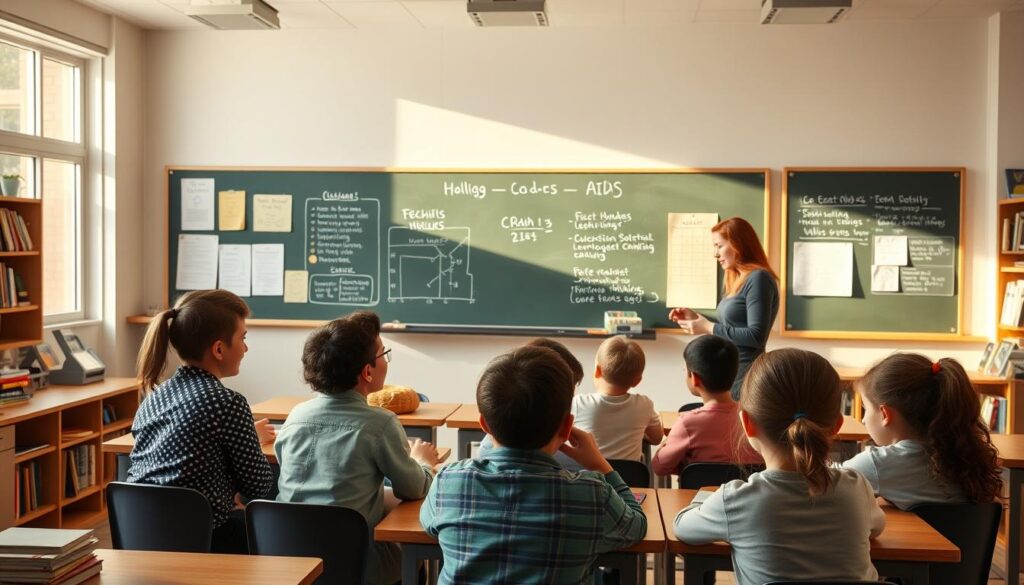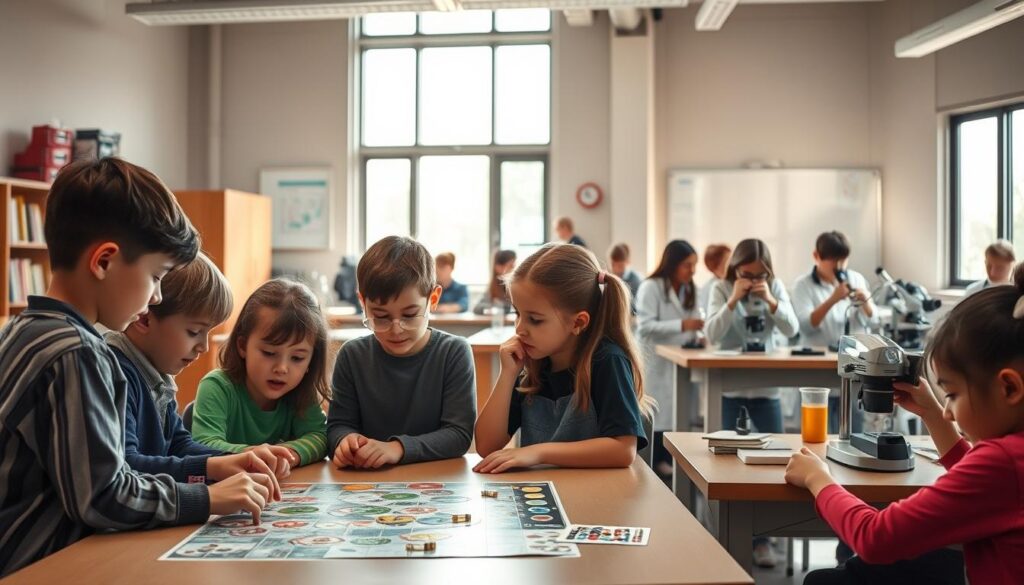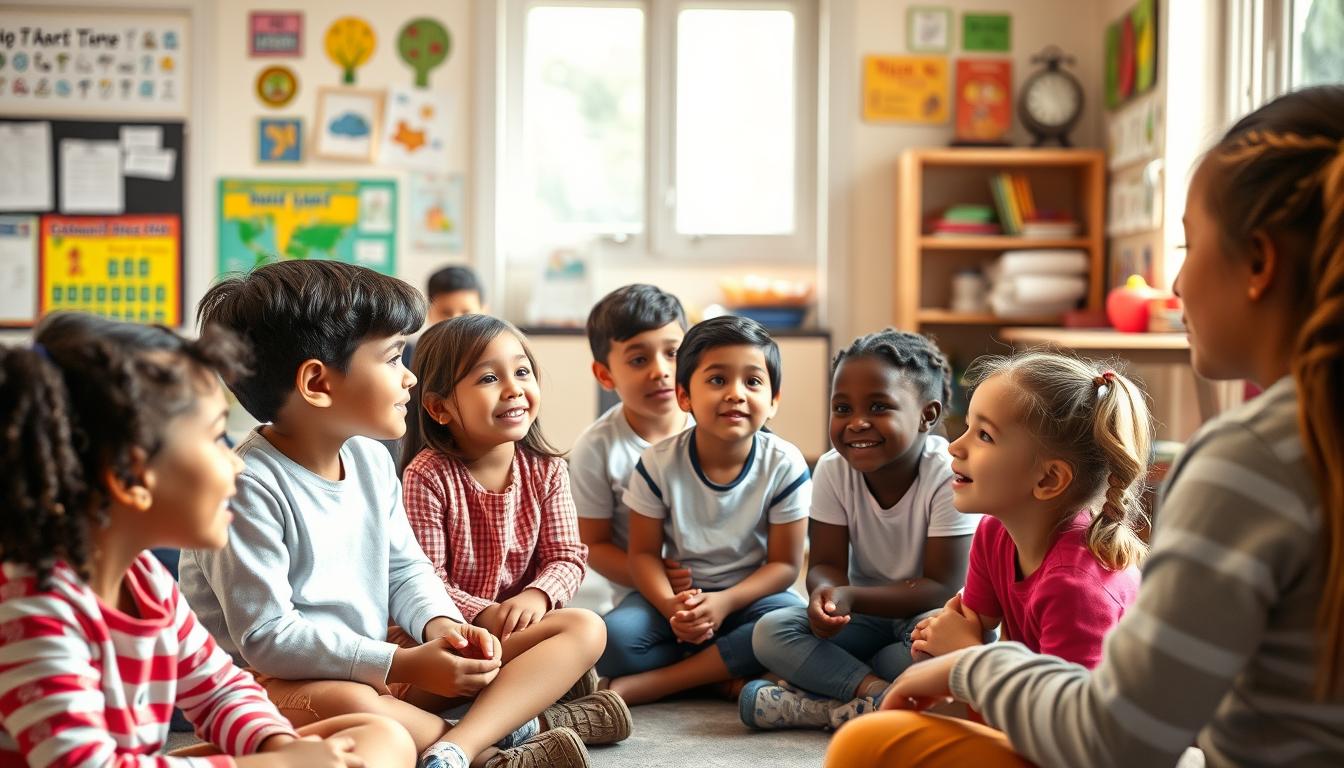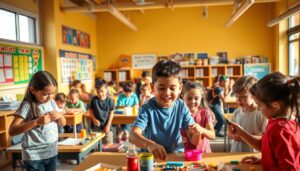How to Teach Critical Thinking to Kids
Did you know students who practice analytical reasoning before age 10 are 72% more likely to excel in complex problem-solving later in life? In a world where 65% of today’s grade-schoolers will work in jobs that don’t exist yet, nurturing sharp minds matters more than ever.
Developing a child’s ability to analyze information isn’t about finding right answers – it’s about asking better questions. This skill transforms how young minds approach homework challenges, social interactions, and even video game strategies.
Schools across America are shifting focus from rote memorization to active learning. Why? Because kids need tools to sift through endless online content, spot biased claims, and make decisions based on evidence. These abilities become their compass for navigating friendships, science projects, and future career choices.
Key Takeaways
- Early development of reasoning skills boosts academic performance and real-world problem-solving
- Children with strong analytical abilities adapt better to unexpected challenges
- Creating safe spaces for questions leads to deeper understanding
- Effective methods turn everyday moments into learning opportunities
- Digital literacy and fact-checking are modern extensions of traditional skills
From dinner table debates to science fair experiments, every interaction can build a child’s confidence in their own judgment. The goal isn’t perfection – it’s helping them develop a mindset that questions, explores, and grows.
Understanding the Importance of Critical Thinking in Children

Educators emphasize that analytical skills formed in childhood shape lifelong learning patterns. These mental tools help kids separate facts from opinions and build confidence in their decision-making. Let’s explore what makes this approach unique and why it matters for young learners.
What Is It Really About?
At its core, this skill set involves teaching kids to ask “why?” before accepting any claim. Experts describe it as organized reasoning that values evidence over guesses. Children learn to spot biases, test ideas, and connect different viewpoints like puzzle pieces.
Seven key traits define this approach:
- Natural curiosity about how things work
- Willingness to consider opposing ideas
- Systematic methods for breaking down problems
Why These Skills Matter
Kids with strong analytical abilities often show 21% higher creativity in school projects compared to peers. They adapt faster when group work goes sideways and handle playground disagreements with clearer communication.
These talents also help outside classrooms. Children become better at:
- Choosing friends who share their values
- Resisting impulsive decisions
- Spotting misleading ads or social media posts
By middle school, students trained in these methods typically demonstrate 3x more independence in homework completion. They view challenges as solvable puzzles rather than roadblocks.
Historical and Philosophical Perspectives on Critical Thinking

The art of questioning assumptions has shaped education for millennia. Long before modern classrooms, ancient innovators developed methods to sharpen young minds through deliberate inquiry.
Socrates’ Revolutionary Approach
In Athenian markets 2,500 years ago, a philosopher changed how we learn. Socrates taught students to challenge authority by asking “What makes you certain?” His method exposed gaps in logic through targeted questions rather than lectures.
This approach transformed education. Instead of memorizing facts, students learned to test ideas against evidence. Plato documented how Socrates compared reasoning to sculpting – chipping away flawed assumptions to reveal truth.
Dewey’s Modern Classroom Legacy
Fast-forward to 1910 America. Educator John Dewey argued that schools should teach how to think, not what to think. His concept of “reflective thinking” encouraged students to connect lessons to real-life problems.
Dewey’s work bridged ancient philosophy with modern needs. He showed how structured reasoning helps children evaluate advertisements, historical claims, and scientific theories. This blend of old wisdom and new methods remains vital in today’s digital age.
These thinkers prove good reasoning isn’t about having answers. It’s about nurturing the courage to ask better questions – a skill that transforms children into confident problem-solvers.
Developing Critical Thinking Skills in Kids
How do children learn to separate facts from fiction or solve complex puzzles? The answer lies in mastering specific building blocks of reasoning. Let’s explore the core components that help young minds process information effectively.
Key Elements of Critical Thinking
Every decision children make involves hidden patterns. The Paul-Elder framework identifies eight essential components:
- Clear purpose behind their questions
- Key assumptions they’re making
- Core concepts being used
- Evidence supporting their ideas
When kids learn to spot these elements, they start seeing connections between math homework and playground disputes. One teacher reported, “Students using this approach solved group projects 40% faster than peers.”
Applying Universal Intellectual Standards
Quality thinking requires checkpoints. Children practice asking:
- Is this information accurate?
- Does it relate to the problem?
- Have we considered different angles?
These standards turn rushed guesses into thoughtful conclusions. A study showed students using these criteria made 63% fewer errors in science experiments compared to traditional methods.
By combining structured elements with quality checks, kids build mental toolkits that grow with them. It’s not about being right every time – it’s about creating thinking habits that last.
Implementing Effective Teaching Strategies

What transforms ordinary lessons into engines for developing sharp minds? Research shows classrooms using active learning methods see 53% higher engagement than traditional lecture formats. Let’s explore practical approaches that turn theory into daily practice.
Interactive Techniques and Problem-Solving Activities
Swap worksheets for real-world scenarios. One middle school replaced math drills with budget-planning exercises for a pretend business. Students tracked profits, debated spending choices, and adjusted strategies weekly.
Effective methods often include:
- Role-playing historical decisions with modern consequences
- Designing solutions for community issues like recycling
- Analyzing product claims through science experiments
| Traditional Approach | Interactive Method | Outcome Difference |
|---|---|---|
| Textbook reading | Case study debates | +41% retention |
| Multiple-choice tests | Peer-designed quizzes | +29% participation |
| Teacher-led demos | Student-run experiments | 3x error discovery |
Incorporating Evidence-Based Discussions
“Show me your sources” becomes the classroom mantra. During current events talks, students practice:
- Identifying primary vs. secondary sources
- Checking author credentials
- Spotting emotional language in articles
A 2014 study of 341 classrooms found that evidence-focused discussions improved argument quality by 67%. One teacher noted, “Students now ask ‘How do we know this?’ before forming opinions.”
“When learners defend ideas with facts rather than feelings, they build reasoning muscles that last a lifetime.”
These strategies create ripple effects. Kids start applying the same scrutiny to social media posts and family debates – proof that classroom habits shape real-world thinking.
Real-World Applications and Engaging Activities

Why do some students spot fake news faster than adults? The answer lies in connecting classroom skills to real-life puzzles they face daily. When lessons mirror authentic challenges, learners grasp how to apply reasoning tools beyond textbooks.
Turning Daily Encounters into Learning Labs
Imagine students dissecting TikTok ads during lunch break. One class project showed learners comparing phone reviews from tech sites versus influencer posts. 58% improved at spotting sponsored content after three weeks of practice.
Effective activities often involve:
- Mapping family budget choices to math concepts
- Debating playground rules using fairness principles
- Testing viral science hacks with kitchen experiments
These methods help young minds see patterns. A teacher shared, “Students who analyzed cafeteria menus started questioning food marketing claims in stores.” This shift demonstrates skill transfer across contexts.
Role-playing exercises reveal hidden angles. When pretending to be mayors deciding park renovations, learners must weigh community needs against costs. Such scenarios teach consequence analysis better than hypothetical worksheets.
“Ambiguity in projects mirrors real life. Our job isn’t to remove uncertainty – it’s to equip kids to navigate it.”
Through these practical approaches, students build mental frameworks for handling misinformation and complex choices. They learn to pause before sharing shocking headlines and rethink knee-jerk reactions – skills that serve them for life.
Conclusion
Nurturing young minds to analyze information carefully creates foundations for lifelong growth. These abilities transform how children approach homework, friendships, and digital content – turning everyday moments into chances to practice reasoned decision-making.
The journey of developing sharp thinkers continues far beyond classrooms. As Linda Elder observes, skilled problem-solvers often become agents of positive change, using their tools to build fairer systems and clearer communication.
Parents and educators help most by modeling curiosity. When adults ask “What evidence supports that claim?” during family discussions, kids learn to value facts over quick assumptions. This mindset becomes their compass for navigating complex choices in adulthood.
True growth happens through practice, not perfection. Each time children compare product reviews or debate game strategies, they strengthen mental muscles needed for future challenges. These small victories prepare them to handle bigger questions about community issues and global concerns.
By making space for questions and honoring thoughtful responses, we equip kids to shape their world with care. That’s the real power of learning how to think – it becomes a gift they’ll use every day of their lives.
FAQ
Why is reasoning important for children’s development?
How does Socratic questioning differ from modern teaching methods?
What are universal intellectual standards in education?
Can everyday situations improve a child’s problem-solving skills?
How do evidence-based discussions benefit young learners?
What role do parents play in fostering analytical skills?

Sharon Molly is a content creator in lifestyle, fashion, and travel, delivering style-savvy advice and destination insights to inspire confident living. With a background in digital media, she combines aesthetics with practical guidance for modern women on the go.




